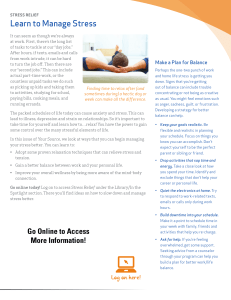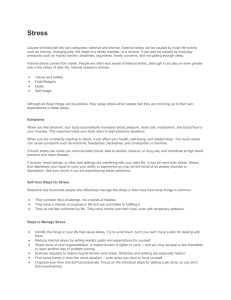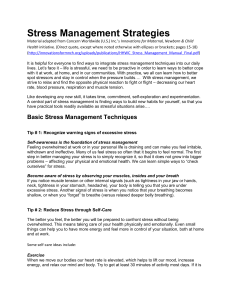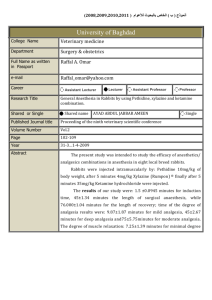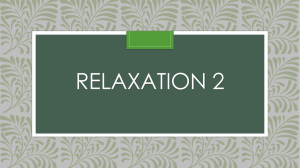Document 12076604
advertisement
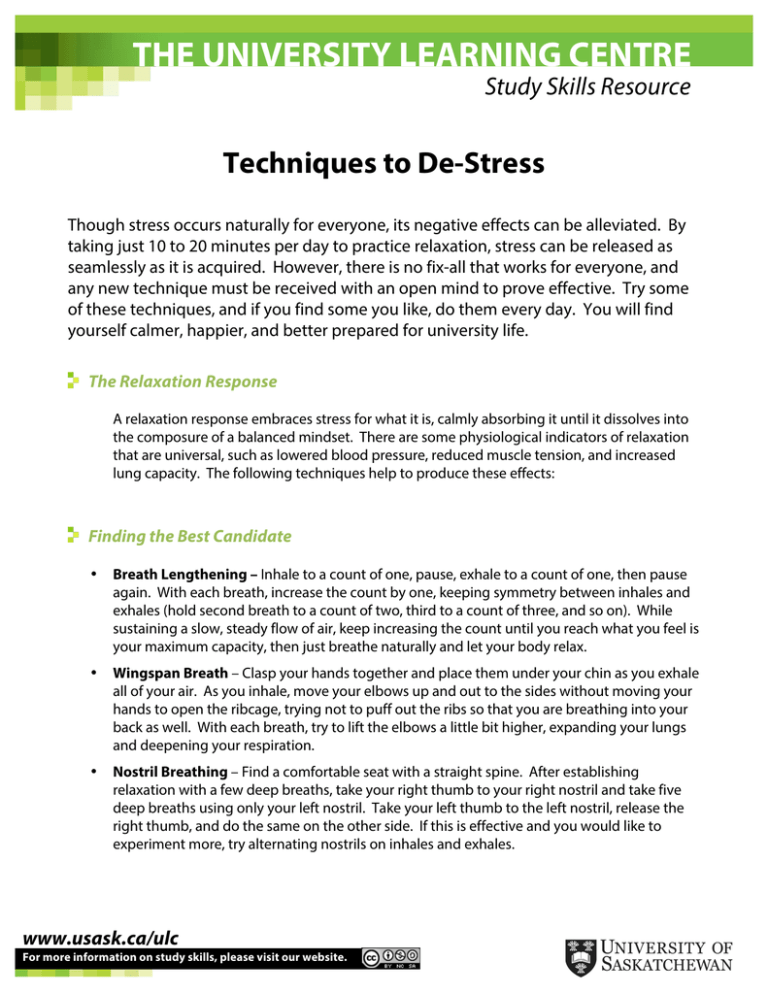
THE UNIVERSITY LEARNING CENTRE Study Skills Resource Techniques to De-Stress Though stress occurs naturally for everyone, its negative effects can be alleviated. By taking just 10 to 20 minutes per day to practice relaxation, stress can be released as seamlessly as it is acquired. However, there is no fix-all that works for everyone, and any new technique must be received with an open mind to prove effective. Try some of these techniques, and if you find some you like, do them every day. You will find yourself calmer, happier, and better prepared for university life. The Relaxation Response A relaxation response embraces stress for what it is, calmly absorbing it until it dissolves into the composure of a balanced mindset. There are some physiological indicators of relaxation that are universal, such as lowered blood pressure, reduced muscle tension, and increased lung capacity. The following techniques help to produce these effects: Finding the Best Candidate • Breath Lengthening – Inhale to a count of one, pause, exhale to a count of one, then pause again. With each breath, increase the count by one, keeping symmetry between inhales and exhales (hold second breath to a count of two, third to a count of three, and so on). While sustaining a slow, steady flow of air, keep increasing the count until you reach what you feel is your maximum capacity, then just breathe naturally and let your body relax. • Wingspan Breath – Clasp your hands together and place them under your chin as you exhale all of your air. As you inhale, move your elbows up and out to the sides without moving your hands to open the ribcage, trying not to puff out the ribs so that you are breathing into your back as well. With each breath, try to lift the elbows a little bit higher, expanding your lungs and deepening your respiration. • Nostril Breathing – Find a comfortable seat with a straight spine. After establishing relaxation with a few deep breaths, take your right thumb to your right nostril and take five deep breaths using only your left nostril. Take your left thumb to the left nostril, release the right thumb, and do the same on the other side. If this is effective and you would like to experiment more, try alternating nostrils on inhales and exhales. www.usask.ca/ulc For more information on study skills, please visit our website. Techniques to De-Stress – Page 2 Study Skills Resource Releasing Muscle Tension • A common technique used for releasing muscle tension is called progressive muscle relaxation. This technique involves rigidly tensing muscles and releasing them, working from the feet up to the face. • Begin by tensing both feet for a full, deep breath, and then relax for three deep breaths. Repeat this process for feet and calves, then both legs (feet, calves, and thighs). From here, move on to the hips and gluts before doing the arms like the legs (beginning with hands, then hands and forearms, and finally hands, forearms, and upper arms). • Next, squeeze your back muscles toward the center of the spine and release, then squeeze the chest and abdominal muscles toward each other, and finish by scrunching up the face. It is crucial to let each muscle group relax for at least twice as long as it was tensed up. Once you have gone through all the muscle groups, simply relax, empty your mind, and enjoy. • Sometimes muscle tension builds up because of mechanical problems in the body. Certain factors such as poor posture, awkward sleeping positions, and repetitive strain can leave muscles tense and sore, depleting energy and motivation. If you feel affected by these issues, talk to a doctor or conduct your own research to help you develop healthier habits. Remember to eat well, be aware of your posture, and exercise regularly. Techniques to Keep You Focused • Meditation – Meditation is an ancient practice with a richness that has been intellectually and spiritually explored for millennia. However, the act of meditation is a fundamentally simple one that anyone can benefit from. Find a comfortable seat, preferably on the floor, though a chair can be used. As you sit, allow yourself to do nothing else. Simply listen to the breath move in and out of your body as your mind empties and the warmth of the energy in your body is all that keeps you awake. • Visualization – Visualization involves forming images in your mind. Some relaxation techniques involve visualization of tranquil landscapes, such as a calm sky reflected in a still lake, or lush trees swaying in a light breeze. Visualization can also be used as a motivational tool and as skill reinforcement. For example, many athletes visualize their performance several times before they actually perform, increasing their confidence in their abilities and psychologically preparing them. The same can be achieved by visualizing taking a test, giving a presentation, or defending a thesis. Whatever the task, visualization can reassure you and even heighten the aptitude that you already possess. Study Hard, but Breathe Easy! www.usask.ca/ulc For more information on study skills, please visit our website.

